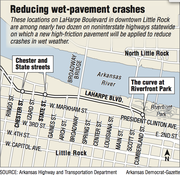A new pavement treatment that has been used on interstates to reduce wet-weather crashes is being modified for application on noninterstate highways with the hopes of achieving the same results: fewer traffic crashes and fatalities.
“It’s a different treatment for the same problem,” said Randy Ort, a spokesman for the Arkansas Highway and Transportation Department.
Two sections of LaHarpe Boulevard in downtown Little Rock are among nearly two dozen locations on noninterstate highways that will receive the new treatment, according to a minute order the Arkansas Highway Commission adopted last month.
LaHarpe, which is also called Arkansas 10, will get the treatment at its intersections with South Chester and South State streets and at the curve near President Clinton Avenue, Ort said.
Other highways on which the treatment will be applied include Arkansas 5 in Garland, Saline, Lonoke and Baxter counties; Arkansas 7 in Clark, Garland and Boone counties; Arkansas 72, Arkansas 102 and Arkansas 279 in Benton County; and Arkansas 65 in Chicot County.
Dubbed high-friction surface treatment, it is part of a Federal Highway Administration-backed initiative that focuses on critical locations such as curves that make up a small part of the U.S. highway system but are the sites of an inordinate number of crashes. The federal agency cites statistics showing that curves make up 5 percent of the nation’s highway system but account for 25 percent of fatalities on those roads.
The treatment already has been applied at six locations on Interstate 30, Interstate 40 and Interstate 440 totaling about 23 miles. The projects collectively cost $6.3 million.
The Federal Highway Administration calls high-friction surface treatment “an emerging technology that has the potential to reduce crashes dramatically and immediately, as well as the related injuries and fatalities.”
The treatments on the interstates address the increased likelihood of hydroplaning at high speeds in the rain. The thin coating provides a texture that will drain more water from the roadway than a typical surface and increase the skid resistance. In addition to reducing the likelihood of hydroplaning, the new texture reduces splash and spray, which can limit visibility and contribute to crashes.
The treatment on noninterstate highways addresses different problems motorists encounter in the rain: losing traction when braking at intersections and, more typically, in curves, Ort said.
“It has more to do with braking or turning,” he said. “It’s the same principle whether you are coming to a curve or to an intersection - you are hitting your brakes.”
The epoxy coating that will be used on the state’s projects compared with the interstate projects contains “sharper aggregate,” or rock, that is “highly abrasive,” Ort said. The increased abrasiveness will aid in braking and control of the vehicle, he said.
The state highway system covers about 16,000 miles. To figure out where to apply the treatment, department officials identified about 1,200 miles of noninterstate highways that had average daily traffic of 1,000 vehicles or more and on which wet pavement was a factor in at least 35 percent of the total crashes.
LaHarpe has an average daily vehicle count of 23,000 at the two intersections and 17,333 at the curve.
The percentage of wet-pavement crashes at the locations the department identified for treatment generally are much higher than 35 percent, according to a department analysis.
The percentage of crashes that happened on wet pavement at the LaHarpe intersections and the curve were 47 percent and 45 percent, respectively, the analysis found.
Five of the projects are on Arkansas 102. The percentage of those crashes that were on wet pavement ranged from 43 percent to 100 percent. All of those locations have curves, Ort said.
A section of Arkansas 72 had the most wet-pavement crashes - 16 - in the years that were analyzed - 2009-11. Of those crashes, four involved fatalities or serious injury. The section had a total of 33 crashes in the time frame covered by the analysis.
Just 23 percent of the crashes on U.S. 65 in Chicot County occurred on wet pavement, but Ort said the department wanted to apply the treatment in different parts of the state to assess differences in rock qualities across Arkansas. The treatment usually involves locally acquired rock, he said.
The treatment is expensive. The 22 locations identified for the treatment total less than 7 miles, but the estimated cost is nearly $3.6 million. The Federal Highway Administration said the added cost is offset by the treatment’s durability.
“While the initial costs are higher than conventional pavement, however, the long-lasting durability of HFS treatment and limited use in critical locations makes the product a low-cost option over its life cycle,” the agency said.
Arkansas, Pages 7 on 04/14/2014
